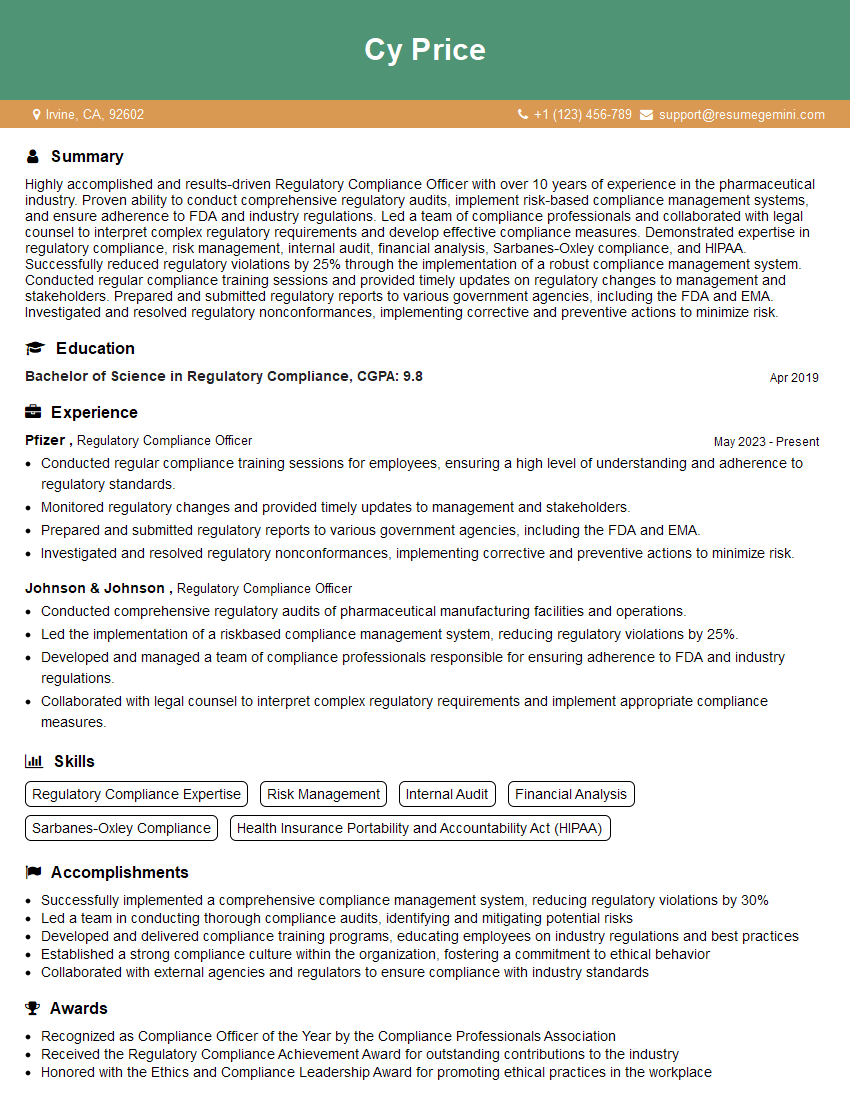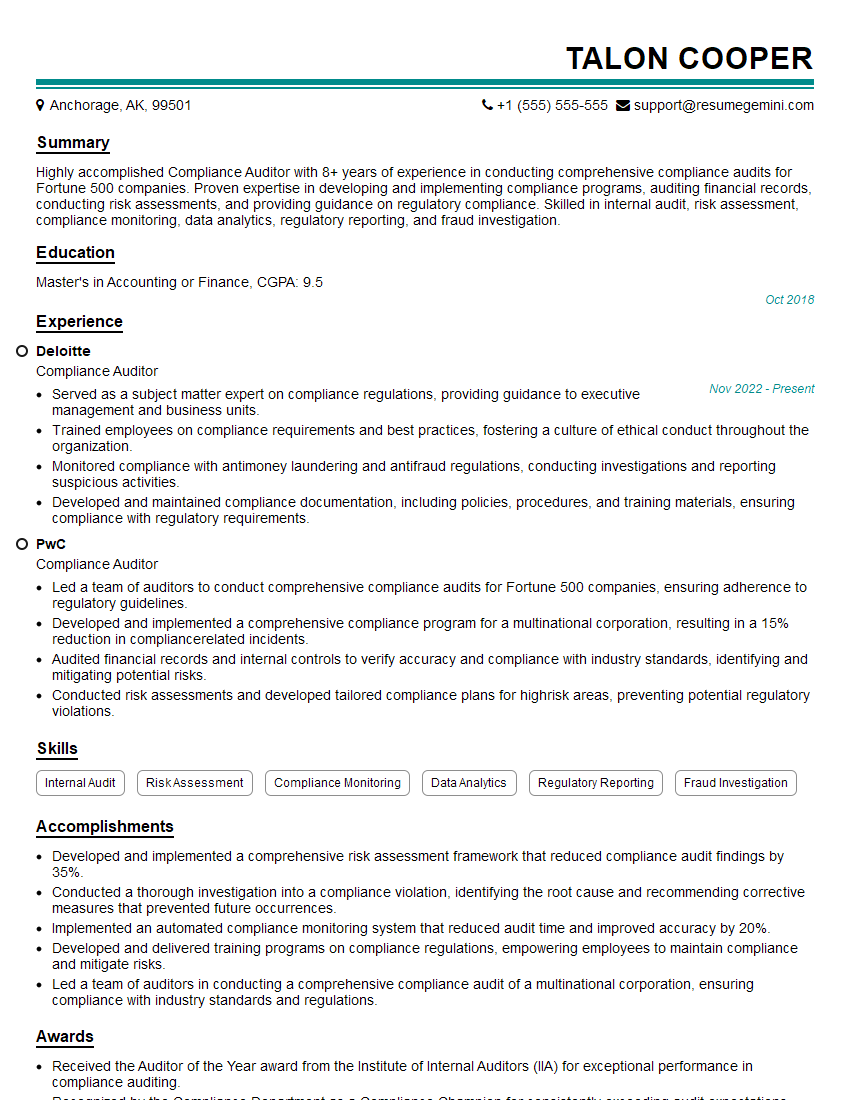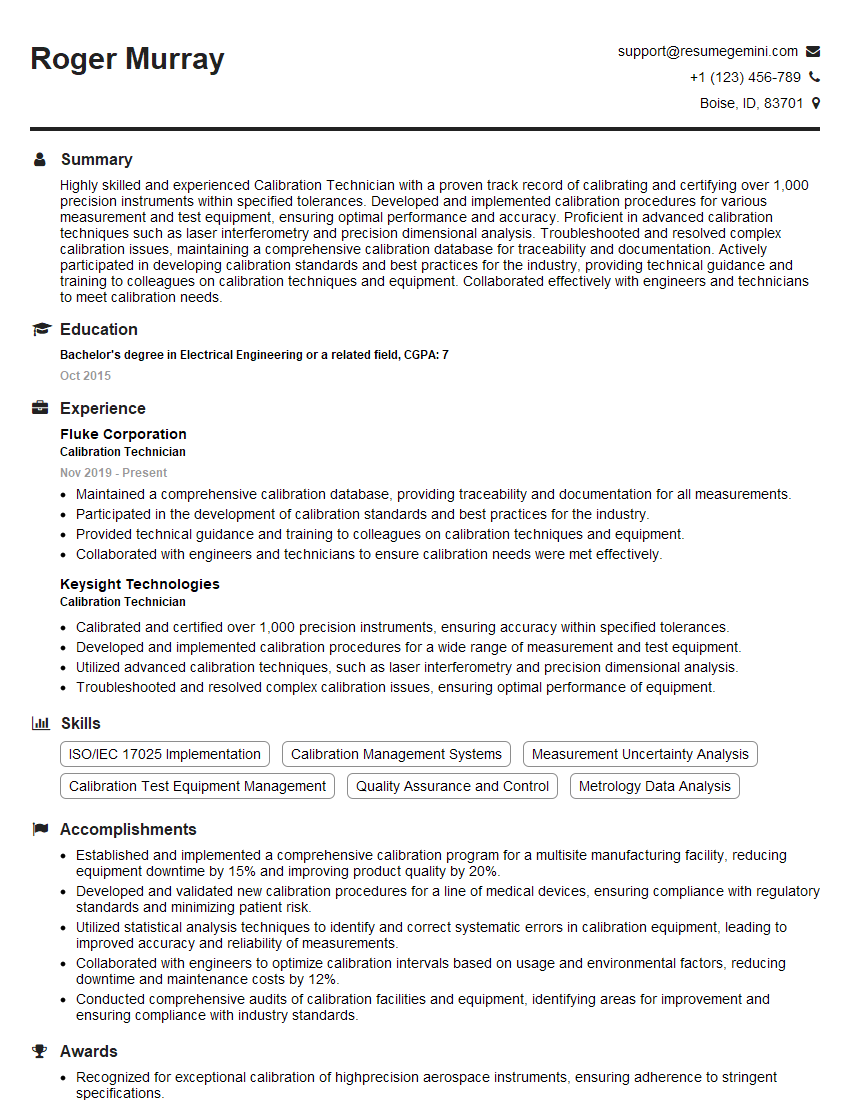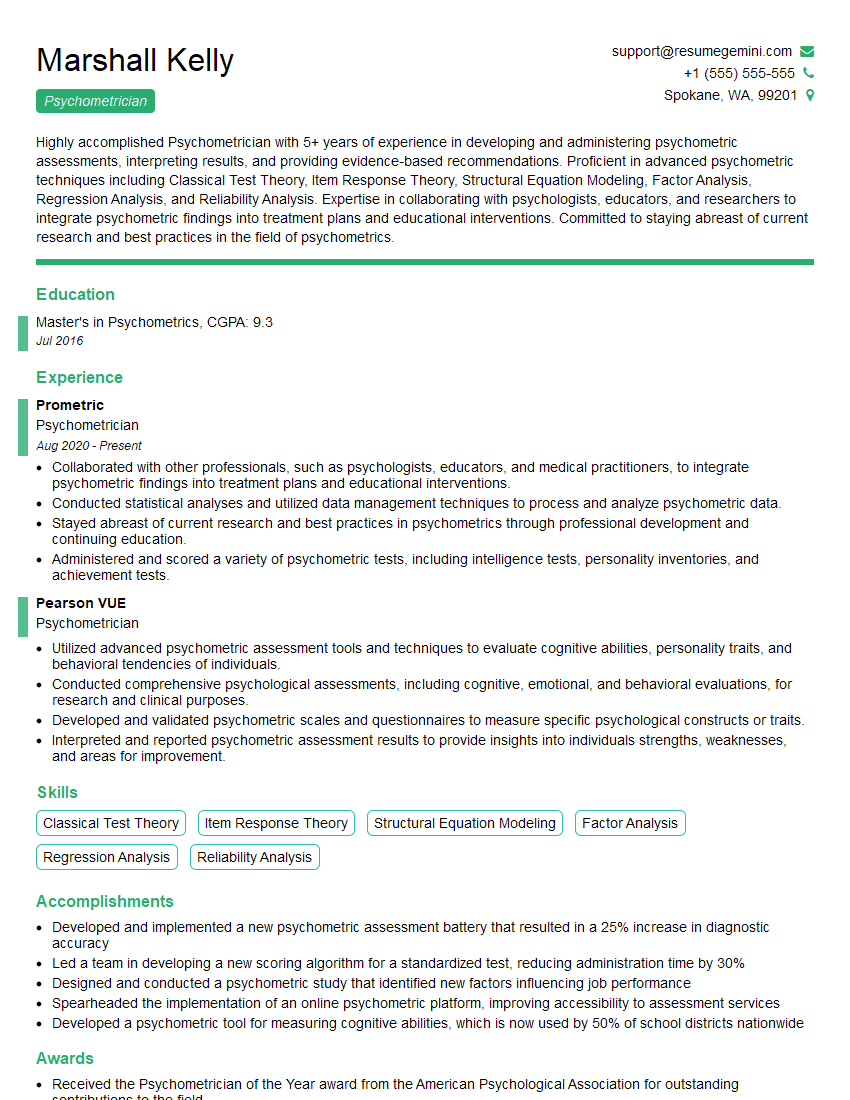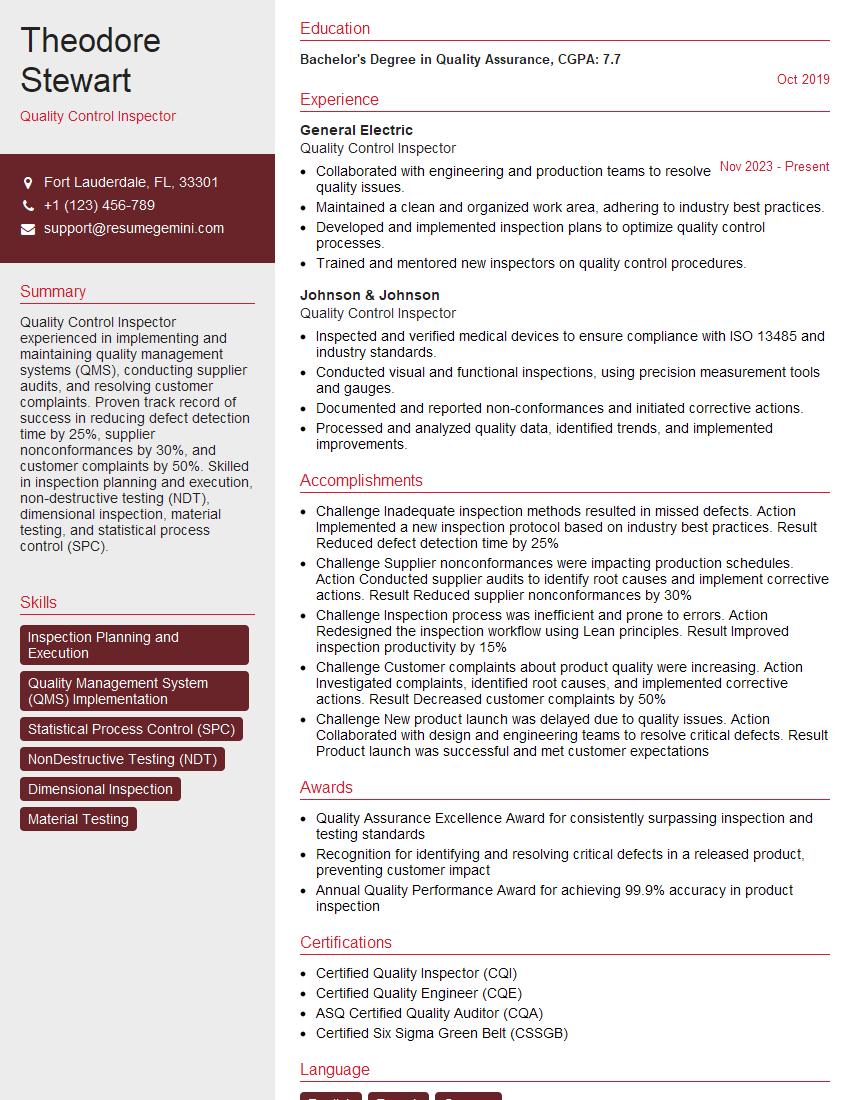Are you ready to stand out in your next interview? Understanding and preparing for Grading According to Standards interview questions is a game-changer. In this blog, we’ve compiled key questions and expert advice to help you showcase your skills with confidence and precision. Let’s get started on your journey to acing the interview.
Questions Asked in Grading According to Standards Interview
Q 1. Explain the importance of standardized grading procedures.
Standardized grading procedures are crucial for ensuring fairness, consistency, and transparency in evaluating student work. Without them, grades can become subjective and unreliable, potentially leading to inequitable outcomes. Standardization provides a common framework for all assessors, ensuring that everyone is evaluating the same criteria using the same standards. This creates a level playing field for students and allows for more accurate comparisons of their performance.
Think of it like a recipe: a standardized grading rubric is like the recipe, outlining the specific ingredients (criteria) and the steps (levels of achievement) needed to achieve the desired outcome (grade). Without a recipe, each chef (assessor) might interpret the dish (assignment) differently, resulting in vastly different final products.
Q 2. Describe your experience with different grading rubrics.
Throughout my career, I’ve worked with a variety of grading rubrics, from simple checklists to complex analytic rubrics. I’ve used holistic rubrics, which provide a single overall score based on a general impression of the work, and analytical rubrics, which break down the assessment into specific criteria, each with its own scoring scale. For example, in assessing essays, I’ve used rubrics that scored on criteria such as argumentation, evidence, organization, and style. In evaluating coding projects, rubrics focused on functionality, efficiency, code style, and documentation were employed. My experience extends to rubrics designed for various learning styles and assessment types, including presentations, projects, and exams.
Q 3. How do you ensure inter-rater reliability in grading?
Ensuring inter-rater reliability is paramount for the validity of any grading system. This involves minimizing discrepancies between the grades assigned by different assessors. Key strategies include:
- Developing clear and concise rubrics: The rubric must leave no room for ambiguity about what constitutes each level of performance.
- Training sessions for assessors: Providing thorough training on the rubric and its application is essential. This often includes practice grading sessions with feedback and discussion to ensure common understanding.
- Calibration exercises: Assessors grade the same sample of student work independently, then compare their grades and discuss any discrepancies. This helps to align their perspectives and refine their understanding of the rubric.
- Statistical analysis: Analyzing the correlation between the grades assigned by different assessors can quantify the level of inter-rater reliability. A high correlation indicates strong agreement.
For instance, before a large-scale assessment, we conduct a calibration exercise where all assessors grade a set of pre-selected assignments. We then discuss any differing scores, resolving discrepancies through consensus or revisiting the rubric’s definition.
Q 4. What are the common challenges in maintaining grading standards?
Maintaining consistent grading standards faces several challenges:
- Subjectivity in assessment: Even with clear rubrics, some degree of subjectivity remains, particularly in assessing open-ended tasks like essays or creative projects.
- Time constraints: The pressure of deadlines can lead to rushed grading, reducing attention to detail and potentially compromising consistency.
- Changes in student performance: If student performance varies significantly from year to year, maintaining the same standards may become challenging. Adjustments to the rubric or grading expectations may be necessary.
- Lack of assessor training or inconsistent application of rubrics: Assessors may interpret rubrics differently or unintentionally deviate from the established standards.
Addressing these challenges requires careful rubric design, ongoing training and calibration, and consistent monitoring of grading practices.
Q 5. How do you handle inconsistencies in grading across different assessors?
Inconsistencies in grading across assessors are addressed through a multi-pronged approach. The first step involves identifying the inconsistencies through statistical analysis (e.g., calculating inter-rater reliability coefficients). Once identified, we initiate a review process. This involves:
- Revisiting the rubric: Determining if the rubric itself is unclear or needs refinement.
- Conducting further training: Providing additional training for assessors on the areas where inconsistencies were found.
- Moderation of grades: A senior assessor reviews a sample of the grades assigned by each assessor to identify and correct significant discrepancies.
- Grade normalization: Statistical methods may be employed to adjust grades to reflect a more consistent scale.
The goal is to ensure fairness and minimize the impact of inconsistencies on student grades.
Q 6. Describe your process for developing a grading rubric.
Developing a grading rubric is an iterative process that involves:
- Defining learning objectives: Clearly stating what students should be able to do by the end of the course or assignment.
- Identifying key criteria: Determining the specific aspects of the assignment that will be evaluated (e.g., content accuracy, organization, writing style).
- Establishing performance levels: Defining different levels of achievement for each criterion (e.g., excellent, good, fair, poor), with clear descriptors for each level.
- Developing scoring scales: Assigning numerical or letter grades to each performance level.
- Pilot testing and refinement: Testing the rubric with a small sample of student work and revising it based on feedback to ensure clarity and effectiveness.
For example, when creating a rubric for a research paper, I would first identify the key criteria such as research question clarity, evidence quality, argumentation, and writing style. I would then define specific descriptors for each level of performance in each criterion. The rubric would be piloted, and based on the results, revisions would be made before final implementation.
Q 7. How do you identify and address bias in grading?
Addressing bias in grading requires careful consideration and proactive measures. Bias can stem from various sources, including:
- Stereotypes: Unconscious biases based on gender, race, socioeconomic status, etc., can influence grading decisions.
- Halo effect: A positive impression in one area influencing assessment in other areas.
- Personal preferences: Favoritism towards certain writing styles or approaches.
Strategies for mitigating bias include:
- Blind grading: Removing student identifiers from assignments before grading.
- Using standardized rubrics: Strict adherence to clear, objective rubrics reduces the scope for subjective judgment.
- Multiple assessors: Having multiple assessors evaluate each assignment and comparing their grades can identify potential biases.
- Regular training and self-reflection: Educating assessors on common biases and encouraging self-reflection on their own grading practices.
A consistent application of these strategies aims to create a more equitable and fair grading process.
Q 8. Explain the difference between formative and summative assessment grading.
Formative and summative assessments differ fundamentally in their purpose and timing within the learning process. Think of formative assessment as the ‘in-flight’ check, providing ongoing feedback to improve learning during the learning process, while summative assessment is the ‘final destination’ evaluation, summarizing learning at the end of a unit or course.
- Formative Assessment: This is ongoing, low-stakes assessment designed to monitor student progress and provide feedback for improvement. Examples include quizzes, class discussions, homework assignments, and drafts of projects. The goal is to identify areas needing further attention before the final evaluation. For example, a teacher might give a short quiz on a chapter to see where students are struggling and adjust their teaching accordingly.
- Summative Assessment: This is a high-stakes assessment used to evaluate student learning at the end of a unit, course, or program. Examples include final exams, term papers, major projects, and standardized tests. The focus is on determining what students have learned and achieved.
The key difference lies in their purpose: formative assessments inform instruction and learning, while summative assessments measure the outcome of learning.
Q 9. How do you ensure the validity and reliability of your grading methods?
Ensuring validity and reliability in grading is paramount for fair and accurate assessment. Validity refers to whether the assessment measures what it intends to measure, while reliability refers to the consistency of the assessment results. I employ several strategies to ensure both:
- Clear Learning Objectives: Assessments are directly aligned with clearly defined learning objectives. This ensures that the assessment directly measures student understanding of the specific skills and knowledge targeted.
- Well-Defined Rubrics: Detailed rubrics provide clear criteria for grading, minimizing subjective bias and ensuring consistent application of standards across all assessments. These rubrics should be shared with students beforehand so they understand expectations.
- Multiple Assessment Methods: Utilizing diverse assessment methods (e.g., essays, presentations, projects, tests) provides a more comprehensive picture of student learning and reduces reliance on a single, potentially flawed, method.
- Inter-rater Reliability Checks: When possible, I incorporate checks on inter-rater reliability. This involves having multiple assessors independently grade the same work and then comparing the scores. Discrepancies highlight areas needing clarification or further training in rubric application.
- Regular Calibration: Periodic calibration sessions with colleagues ensure that we maintain consistency in our grading practices and interpretations of rubrics.
For example, if I’m assessing student writing, I’d use a rubric that specifically outlines criteria for clarity, organization, grammar, and argumentation. Regularly comparing grades with colleagues on a sample of student work ensures consistent application of the rubric.
Q 10. What are the key elements of a well-designed grading rubric?
A well-designed grading rubric is the cornerstone of fair and transparent assessment. It provides clear criteria and standards, guiding assessors toward consistent and objective evaluations. Key elements include:
- Clear Criteria: The rubric explicitly states the specific aspects of the work being assessed. For example, for an essay, criteria might include thesis statement clarity, evidence quality, argumentation, and grammar.
- Performance Levels: The rubric defines different levels of performance for each criterion (e.g., Excellent, Good, Fair, Poor). Each level should be described with specific, observable characteristics.
- Descriptive Descriptors: Each performance level is described with detailed, observable characteristics. Instead of simply saying ‘Good’, the descriptor might read: ‘Thesis statement is clear and concise; evidence is relevant and effectively integrated; argumentation is logical and persuasive; grammar is largely error-free.’
- Scoring System: A clear and consistent scoring system (e.g., numerical scores, points, or letter grades) is used to reflect performance levels.
- Accessibility: The rubric is written in clear and concise language, understandable to both assessors and students.
A well-structured rubric minimizes ambiguity and ensures consistent application of grading standards, thus promoting fairness and reducing bias.
Q 11. How do you manage large volumes of assessment materials for grading?
Managing large volumes of assessment materials efficiently requires a systematic approach. I utilize several strategies to streamline the grading process:
- Organized File System: Implementing a clear and organized digital filing system is critical. This allows for easy retrieval and tracking of assignments.
- Batch Grading: Grouping similar assignments together allows for more efficient grading, as I can focus on a specific type of task at a time.
- Technology Tools: Using tools like Learning Management Systems (LMS) with automated grading features (where applicable) helps to manage and track grades, reducing manual input.
- Prioritization: Prioritizing assignments based on deadlines and importance helps to manage workload effectively.
- Delegation (where appropriate): In some contexts, delegation of grading tasks to teaching assistants, under my supervision and with clearly defined rubrics, can be effective.
For example, I might utilize an LMS to collect assignments, then download and grade them in batches using a standardized rubric. The grades are then re-uploaded to the LMS for easy access by students.
Q 12. Describe your experience with using technology for grading and assessment.
Technology has significantly enhanced my grading and assessment practices. I’ve extensively used Learning Management Systems (LMS) such as Canvas and Blackboard for online submission, grading, and feedback delivery. These systems automate many tasks, such as grade calculation and distribution. I’ve also explored the use of automated essay scoring tools for initial assessment, recognizing that these tools are best used in conjunction with human judgment for a holistic evaluation.
Furthermore, I’ve used various software for creating and managing rubrics, ensuring consistency and ease of use. This aids in inter-rater reliability checks when multiple graders are involved. Specific examples include utilizing digital annotation tools for providing feedback directly on student work within the LMS, making the process faster and more efficient than traditional paper-based feedback.
Q 13. How do you provide feedback to assessors on their grading performance?
Providing regular feedback to assessors is vital for maintaining consistent grading standards. My approach involves:
- Calibration Sessions: Regular meetings to discuss grading practices, review sample assignments, and address discrepancies in grading. This ensures a shared understanding of the rubrics and expectations.
- Individual Feedback: Providing tailored feedback based on individual assessor performance. This might include highlighting areas of strength and areas needing improvement in rubric application or providing specific examples of inconsistencies.
- Data Analysis: Analyzing aggregate grading data to identify trends and patterns in grading inconsistencies. This provides a broader perspective on grading performance across all assessors.
- Professional Development: Providing opportunities for professional development to enhance assessors’ grading skills and knowledge of best practices.
For instance, if I notice an assessor consistently awarding higher or lower grades than their peers, I’d meet with them individually to discuss their grading approach, review sample assessments, and ensure they understand the rubric’s criteria.
Q 14. What are the ethical considerations in grading and assessment?
Ethical considerations in grading and assessment are crucial for ensuring fairness, equity, and promoting student learning. Key ethical considerations include:
- Bias Awareness: Recognizing and mitigating potential biases based on factors such as student background, gender, or socioeconomic status. This requires careful consideration of assessment design and grading practices.
- Transparency and Fairness: Ensuring that grading criteria and processes are clear, transparent, and consistently applied. This promotes trust and reduces the potential for perceived unfairness.
- Confidentiality: Maintaining the confidentiality of student assessments and grades. Sharing assessment information with unauthorized individuals is unethical.
- Avoiding Conflicts of Interest: Avoiding any situations that could create a conflict of interest when grading student work.
- Accuracy and Integrity: Ensuring the accuracy and integrity of assessment results by using valid and reliable assessment methods.
For example, using anonymous grading can help to minimize bias based on student identities. Providing clear feedback based on objective criteria ensures that students understand the rationale behind their grades and are able to improve their learning. Furthermore, upholding confidentiality of grades is critical to protecting students’ privacy and academic records.
Q 15. How do you deal with appeals or disputes regarding grades?
Appeals regarding grades are a crucial part of ensuring fairness and transparency. My approach involves a structured process. First, I review the student’s work and the grading rubric carefully, looking for any discrepancies between the applied criteria and the assigned grade. Then, I document the rationale behind my original grading decision. If the student provides compelling evidence – for example, if a misunderstanding of instructions led to an incorrect answer or there’s a clear scoring error – I’m open to adjusting the grade accordingly.
This process necessitates clear communication. I schedule a meeting with the student to discuss the appeal, ensuring a respectful and collaborative environment. We go through the assessment together, point by point, allowing the student to explain their reasoning. If necessary, I may consult with colleagues for a second opinion. Finally, I communicate the decision with a clear written explanation, justifying any changes to the original grade or maintaining the original grade with clear reasons. This process isn’t just about resolving disputes, it’s about fostering learning and ensuring students understand the assessment criteria.
Career Expert Tips:
- Ace those interviews! Prepare effectively by reviewing the Top 50 Most Common Interview Questions on ResumeGemini.
- Navigate your job search with confidence! Explore a wide range of Career Tips on ResumeGemini. Learn about common challenges and recommendations to overcome them.
- Craft the perfect resume! Master the Art of Resume Writing with ResumeGemini’s guide. Showcase your unique qualifications and achievements effectively.
- Don’t miss out on holiday savings! Build your dream resume with ResumeGemini’s ATS optimized templates.
Q 16. How do you ensure the confidentiality of assessment data?
Confidentiality of assessment data is paramount. I adhere strictly to privacy policies and relevant regulations. Student work is stored securely, both physically and digitally. This includes using password-protected files, secure online platforms, and limiting access to authorized personnel only. I never share grades or assessment details publicly or with unauthorized individuals. When discussing student performance, I always use anonymous examples or aggregated data to protect individual privacy. Even within the grading team, discussion of specific student performance is limited to what is necessary for grading consistency and feedback purposes. This commitment to confidentiality builds trust and respects the privacy rights of every student.
Q 17. Describe your experience with different types of assessments (e.g., multiple-choice, essays, performance-based).
My experience encompasses a broad range of assessment types. I’ve extensively used multiple-choice questions for evaluating factual knowledge and understanding, designing them to minimize ambiguity and ensure clear scoring. For more in-depth analysis of critical thinking and writing skills, I regularly employ essay assessments, using rubrics that focus on argumentation, evidence, and clarity. Performance-based assessments, like presentations or lab reports, are also valuable tools in my assessment toolbox; these allow me to evaluate practical application and problem-solving skills directly. In each case, the choice of assessment type depends on the learning objectives, and I carefully consider the strengths and weaknesses of each method to create a comprehensive and fair assessment of student learning.
Q 18. How do you adapt grading standards for different learner needs or abilities?
Adapting grading standards for diverse learners requires a nuanced approach. While maintaining consistent expectations for learning outcomes, I adjust the assessment *methods* to cater to different needs. For students with learning disabilities, for example, I might provide extended time, alternative formats, or assistive technologies. I might also break down complex tasks into smaller, more manageable steps. For gifted learners, I can provide opportunities for enrichment, such as independent projects or advanced research. This doesn’t mean lowering standards; rather, it’s about providing equitable access to demonstrating understanding. The key is to focus on the student’s learning process and achievement relative to their individual capabilities, using differentiated assessment to create a fair and challenging learning experience for everyone.
Q 19. Explain your understanding of statistical methods used in grading analysis.
Statistical methods play a critical role in ensuring grading fairness and accuracy. I use descriptive statistics, such as calculating mean scores and standard deviations, to understand the overall distribution of grades. This helps identify potential issues, like a test being too difficult or too easy. I might also use inferential statistics, comparing performance across different groups of students or on different assessment types, to detect any biases or inconsistencies. For example, a t-test can be used to compare the average scores of two groups. This data-driven approach enables me to refine assessments and identify areas needing improvement. Furthermore, understanding correlation helps me analyze the relationship between different assessment items and overall performance, giving insight into how students learned and how to improve future assessments.
Q 20. How do you maintain consistency in grading across different assessment formats?
Maintaining consistency across different assessment formats demands careful planning and execution. The cornerstone is a clearly defined grading rubric. This rubric should outline specific criteria and scoring guidelines for each assessment type, ensuring that the same standards are applied regardless of the format. For example, if assessing writing, I would create a rubric that includes criteria for argumentation, evidence, structure, and style – this rubric can then be adapted for essays, reports, and presentations. Regular calibration sessions with colleagues, where we grade the same sample assessments, help to identify and address inconsistencies in our individual grading practices. Through this process, we ensure that our interpretation of the rubric aligns and enhances grading consistency across different assessment formats.
Q 21. What are your strategies for improving the efficiency of the grading process?
Improving grading efficiency involves employing various strategies. First, utilizing technology like automated grading software for multiple-choice questions can save significant time. Second, creating well-defined rubrics and utilizing standardized grading protocols reduces ambiguity and speeds up the process. Third, I prioritize efficient organization of student work and grading documents. Fourth, I schedule dedicated grading time, minimizing interruptions. Finally, effective communication with students minimizes the time spent on clarifying instructions or addressing individual disputes. By systematically employing these methods, I can optimize my grading process, maximizing efficiency without compromising the quality and fairness of assessment.
Q 22. How do you stay updated on best practices in grading and assessment?
Staying current in grading best practices requires a multi-faceted approach. It’s not a one-time effort but an ongoing commitment to professional development. I actively participate in professional organizations like the Association for Supervision and Curriculum Development (ASCD) and attend their conferences and webinars focused on assessment and grading. These events often feature leading experts sharing research-based strategies and innovative techniques. I also regularly read peer-reviewed journals focusing on educational measurement and assessment, seeking articles that explore new grading models or methods for improving validity and reliability. Further, I regularly review and update my grading rubrics based on current research and best practices, aligning them with learning objectives and standards. Finally, I actively engage in professional learning communities (PLCs) with colleagues to share strategies, discuss challenges, and collectively refine our grading approaches.
Q 23. Describe your experience with quality control procedures in grading.
Quality control in grading is paramount to ensure fairness and accuracy. My approach involves multiple layers. Firstly, I utilize detailed rubrics that clearly define criteria and scoring levels for each assessment. These rubrics are designed to minimize subjectivity and promote consistency. Secondly, I employ inter-rater reliability checks, particularly for subjective assessments like essays or projects. This involves having another qualified grader independently assess a sample of the work, comparing scores and resolving any discrepancies through discussion. This process helps identify any biases or inconsistencies in my grading. Thirdly, I regularly review my own grading for patterns or trends that might suggest bias or inconsistencies. I keep a log of difficult grading decisions, noting my rationale and any changes made during the process. This allows for self-reflection and continuous improvement. Finally, I maintain open communication with students, clarifying expectations and providing feedback that facilitates their learning.
Q 24. How do you document and track grading decisions and rationale?
Documenting and tracking grading decisions is crucial for transparency and accountability. I maintain a detailed grading record for each assignment, including the rubric used, specific student scores, and detailed comments explaining the rationale behind the grade. This information is typically stored in a secure digital grading platform, offering a readily accessible audit trail. For subjective assessments, I often record audio or video notes while grading to capture my thought process and justification. This helps during discussions with students or when addressing grading appeals. In cases of grading discrepancies, I document the original grade, the revised grade, and a detailed explanation of the reason for the change, maintaining a complete record of every decision made.
Q 25. How do you communicate grading results effectively to stakeholders?
Effective communication of grading results is vital for student success and stakeholder understanding. I communicate grades through a learning management system (LMS) which allows for immediate access to results and feedback. Beyond simply reporting the numerical grade, I provide detailed, constructive feedback explaining the strengths and weaknesses of the student’s work, referencing specific criteria from the rubric. I schedule regular meetings with students to discuss their progress and offer additional support. For parents and guardians, I utilize the LMS and also offer scheduled meetings to discuss student performance, highlighting areas where improvement is needed and celebrating successes. I aim to frame the feedback in a way that focuses on growth and learning, rather than solely on the numerical grade.
Q 26. Explain your experience using specific grading software or platforms.
I have extensive experience using various grading platforms, including Canvas and Moodle. These platforms offer robust features for creating and managing assessments, providing automated grading for objective questions, and facilitating feedback delivery. I find that these platforms offer a streamlined approach to grading, especially when dealing with a large number of students and diverse assessment types. Canvas, for example, allows for the easy creation and implementation of rubrics, making grading more consistent and objective. Moodle’s assignment features offer similar capabilities for managing assignments, feedback, and grading workflows. The ability to provide personalized feedback within these systems is a significant advantage for enhancing student learning.
Q 27. Describe a situation where you had to resolve a grading discrepancy.
In one instance, a grading discrepancy arose during the assessment of a student’s research paper. My initial grading was lower than expected, mainly due to an oversight in acknowledging a nuanced argument presented in the conclusion. Another grader reviewing the paper, as part of our quality control process, identified this omission. Through discussion, we clarified the grading rubric’s expectations regarding the depth of analysis required in the conclusion. This led to a revised grade reflecting the student’s improved performance, alongside a revised rubric to prevent similar situations in the future. This experience highlighted the importance of clear communication, consistent application of rubrics, and the benefits of collaborative grading processes. The student appreciated the thorough review and the opportunity to better understand the feedback, demonstrating the positive impact of addressing grading discrepancies transparently and fairly.
Q 28. How do you balance the need for objectivity with the need for fairness in grading?
Balancing objectivity and fairness in grading requires a thoughtful and nuanced approach. Objectivity involves using standardized rubrics and criteria, minimizing personal biases in the evaluation process. However, fairness goes beyond strict adherence to rubrics. It requires recognizing the unique circumstances of each student, while maintaining consistent standards. For example, a student struggling with a learning disability might require different assessment methods or accommodations to demonstrate their understanding. Fairness necessitates incorporating these considerations while ensuring all students are assessed against the same learning objectives. This involves careful documentation of any adjustments made, ensuring transparency and consistency. Essentially, objectivity provides a framework, while fairness ensures that the framework is applied equitably in the context of individual student needs. The challenge lies in striking a balance between these two critical aspects, recognizing that true fairness sometimes requires flexibility within a system designed for objectivity.
Key Topics to Learn for Grading According to Standards Interview
- Understanding the Standards: Thoroughly familiarize yourself with the specific grading standards relevant to the role. This includes understanding the criteria, weightings, and rubrics used for assessment.
- Fair and Consistent Application: Practice applying the standards consistently and fairly across different student work, ensuring objectivity and minimizing bias. Consider scenarios where inconsistencies might arise and how to address them.
- Providing Constructive Feedback: Develop your skills in providing clear, actionable, and constructive feedback that aligns with the grading standards. Understand how to offer both positive reinforcement and areas for improvement.
- Utilizing Technology for Grading: Explore any technological tools or platforms used for grading, such as learning management systems (LMS). Understand their functionalities and how to efficiently utilize them for grading and feedback.
- Addressing Challenging Situations: Prepare for scenarios involving challenging student work, borderline grades, or disputes regarding grading. Consider strategies for handling these situations professionally and transparently.
- Professionalism and Ethics: Understand the ethical considerations involved in grading, such as maintaining confidentiality and upholding academic integrity. Be prepared to discuss your approach to ethical dilemmas.
- Data Analysis and Reporting: If applicable, be prepared to discuss how you would analyze grading data to identify trends, areas for improvement in instruction, or overall student performance.
Next Steps
Mastering Grading According to Standards demonstrates crucial skills in assessment, feedback, and objective evaluation—highly valued in many education-related roles. A strong grasp of these principles significantly enhances your career prospects and opens doors to various opportunities for growth and advancement. To further strengthen your application, focus on creating an ATS-friendly resume that highlights your relevant skills and experience. ResumeGemini is a trusted resource to help you build a professional resume that showcases your qualifications effectively. Examples of resumes tailored to Grading According to Standards are available to guide you.
Explore more articles
Users Rating of Our Blogs
Share Your Experience
We value your feedback! Please rate our content and share your thoughts (optional).
What Readers Say About Our Blog
This was kind of a unique content I found around the specialized skills. Very helpful questions and good detailed answers.
Very Helpful blog, thank you Interviewgemini team.

